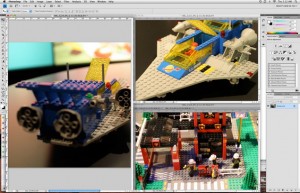Making Color Overlay work
 If you’ve ever tried Photoshop’s Color Overlay Layer Style, you may have been disappointed in how it works (I know I was at first), because rather than overlaying a transparent color over your object, it pretty much puts a solid fill over it. To get this Layer Style to work the way it probably should, all you have to do is change the Blend Mode in the Color Overlay dialog box from Normal to (get this…) Overlay. That way, the color doesn’t obliterate the effects you’ve already applied. Try it and you’ll see what I mean.
If you’ve ever tried Photoshop’s Color Overlay Layer Style, you may have been disappointed in how it works (I know I was at first), because rather than overlaying a transparent color over your object, it pretty much puts a solid fill over it. To get this Layer Style to work the way it probably should, all you have to do is change the Blend Mode in the Color Overlay dialog box from Normal to (get this…) Overlay. That way, the color doesn’t obliterate the effects you’ve already applied. Try it and you’ll see what I mean.
Getting rid of the checkerboard pattern
This should really be called "How to get rid of that annoying checkerboard pattern." I’m talking about the gray-and-white pattern that appears behind transparent layers to let you know which parts of the layer are transparent. In most cases you don’t need this pattern, because you already have something that lets you see what’s transparent on a layer–they’re called your eyes. Because of that, I constantly have people asking me how to turn it off, so I thought I’d better include this information in the book. You go under the Photoshop menu, under Preferences, and choose Transparency & Gamut. Under Transparency Settings, choose None for Grid Size, click OK, and the pattern will be gone.
Saving selections for later use
If you have a selection that you think you can use later in the same project, you can save and store that selection until you need it. Here’s how: While your selection is active, go under the Select menu and choose Save Selection. When the dialog box appears, just click OK. Your selection is now saved. If you want to get that selection back onscreen at any time, go under the Select menu, but this time choose Load Selection. When the dialog box appears, chose your saved selection (named Alpha 1) from the Channel pop-up menu, and click OK. Your saved selection will then appear within your image.
Choosing your canvas color made easier
In Photoshop CS you no longer have to choose a Background color before you enter the Canvas Size dialog (Image>Canvas Size). Now you can choose the color you’d like your increased canvas area to be from the bottom of the Canvas Size dialog. You can click on the Color Swatch and pick a custom color, choose white or black from the pop-up menu, or choose to use the current Foreground or Background color.
How to navigate your image when you’re zoomed in close
When you’ve zoomed in on an image, trying to navigate using the scroll bars is frustrating at best, because when you’re zoomed in really close, even a small move with the scroll bar can move the area you’re working on totally out of the image window. Instead, when you’ve zoomed in, hold the Spacebar and your pointer will temporarily change to the Hand tool, and you can click-and-drag around your image. This is an ideal way to move quickly around your zoomed image, without the frustration of the scroll bars. When you release the Spacebar, you immediately switch back to the tool you were using.
Starting from scratch with your Brush
You want to edit a brush, or create a new one for that matter, and you want to start with a clean slate (i.e., you want all the option settings for the various brush controls set back to their defaults). Then, in the Brushes palette, click on the options you want to edit (e.g., Brush Dynamics, Scattering, Texture, etc.), and from the paletteÕs drop-down menu choose ÒClear Brush Controls.Ó This will clear all the current settings and it also deselects the entire panel, so you may have to click on the option you want again; but when you do, all the default settings will be in place.
How to delete extra brushes
If youÕve created a brush (or a number of brushes) that you donÕt want to appear in your Brushes palette, all you have to do is go to the Brushes Picker in the Options Bar and hold the Option key (PC: Alt key) and your cursor will change to an icon of a pair of scissors. Click once with the scissors on the brush that you want to delete and itÕs gone. If you decide that you want all of your new brushes deleted and that you want to return to the original factory default brushes, choose Reset Brushes from the PickerÕs pop-down menu.
Paint tools have Blend Modes too
YouÕre probably familiar with layer Blend Modes, where you change how a layer interacts with the layers beneath it. In Normal mode, it doesnÕt interact; it just covers whateverÕs beneath it. Well, PhotoshopÕs paint tools have the same feature, and choosing any Blend Mode (other than Normal) allows your paint to interact with (be affected by) the colors in the image you paint on. These Blend Modes are accessed from the Options Bar when you have a paint tool selected.


No comments
Be the first one to leave a comment.